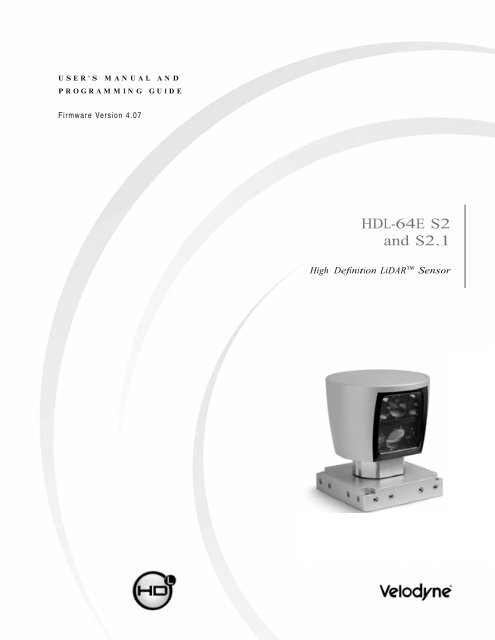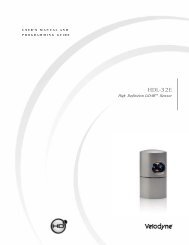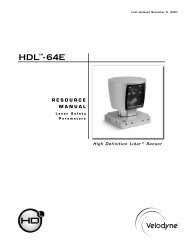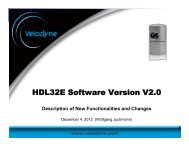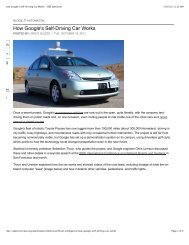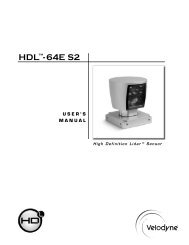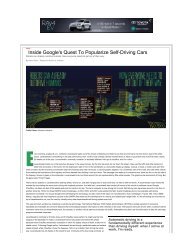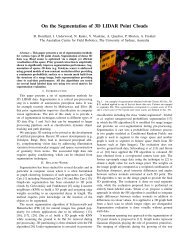HDL-64E S2 Manual - Velodyne Lidar
HDL-64E S2 Manual - Velodyne Lidar
HDL-64E S2 Manual - Velodyne Lidar
You also want an ePaper? Increase the reach of your titles
YUMPU automatically turns print PDFs into web optimized ePapers that Google loves.
U S E R ’ S M A N U A L A N D<br />
P R O G R A M M I N G G U I D E<br />
F i r m w a r e Ve r s i o n 4 . 0 7<br />
<strong>HDL</strong>-<strong>64E</strong> <strong>S2</strong><br />
and <strong>S2</strong>.1<br />
High Definition LiDAR Sensor
i S A F E T Y N O T I C E S<br />
1 I N T R O D U C T I O N<br />
In The Box<br />
2 P R I N C I P L E S O F O P E R A T I O N<br />
3 I N S T A L L A T I O N O V E R V I E W<br />
3 FrontlBack Mounting<br />
4 Side Mounting<br />
5 Top Mounting<br />
6 Wiring<br />
6 U S A G E<br />
6 Use the Included Point-cloud Viewer<br />
6 Develop Your Own Application-specific<br />
Point-cloud Viewer<br />
7 db.xml Calibration Parameters<br />
8 Change Run-Time Parameters<br />
1O Control Spin Rate<br />
— Change Spin Rate in Flash Memory<br />
— Change Spin Rate in RAM Only<br />
1O Limit Horizontal FOV data Collected<br />
11<br />
Define Sensor Memory IP Source<br />
and Destination Addresses<br />
11 Upload Calibration Data<br />
11 External GPS Time Synchronization<br />
— GPS Receiver Option 1:<br />
<strong>Velodyne</strong> Supplied GPS Receiver<br />
— GPS Receiver Option 2:<br />
Customer Supplied GPS Receiver<br />
13 Packet Format and Status Byte<br />
for GPS Time Stamping<br />
13 Time Stamping Accuracy Rules<br />
13 Laser Firing Sequence and Timing<br />
14 F I R M W A R E U P D A T E<br />
15 A P P E N D I X A : Mechanical Drawings<br />
16 A P P E N D I X B : Wiring Diagram<br />
17 A P P E N D I X C : Digital Sensor Recorder (DSR)<br />
17 Install<br />
17 Calibrate<br />
17 Live Playback<br />
18 Record Data<br />
18 Playback of Recorded Files<br />
19 DSR Key Controls<br />
19 DSR Mouse Controls<br />
2O A P P E N D I X D : Matlab Sample Code<br />
22 Reading Calibration and Sensor Parameter Data<br />
23 A P P E N D I X E : Data Packet Format<br />
27 Last Six Bytes Examples<br />
3O A P P E N D I X F : Dual Two Point Calibration Methodology<br />
34 A P P E N D I X G : Ethernet Transmit Timing Table<br />
36 A P P E N D I X H : Laser and Detector Arrangement<br />
37 A P P E N D I X I : Angular Resolution<br />
38 T R O U B L E S H O O T I N G<br />
38 S E R V I C E A N D M A I N T E N A N C E<br />
39 S P E C I F I C A T I O N S
C A U T I O N — S A F E TY<br />
NOTIC E<br />
Caution<br />
To reduce the risk of electric shock and to avoid violating the warranty, do not open sensor body. Refer servicing<br />
to qualified service personnel.<br />
The lightning flash with arrowhead symbol is intended to alert the user to the presence of uninsulated<br />
“dangerous voltage” within the product’s enclosure that may be of sufficient magnitude to constitute a risk of<br />
electric shock to persons.<br />
The exclamation point symbol is intended to alert the user to the presence of important operating and<br />
maintenance (servicing) instructions in the literature accompanying the product.<br />
1. Read Instructions — All safety and operating instructions should be read before the product is operated.<br />
2. Retain Instructions — The safety and operating instructions should be retained for future reference.<br />
3. Heed Warnings — All warnings on the product and in the operating instructions should be adhered to.<br />
4. Follow Instructions — All operating and use instructions should be followed.<br />
5. Servicing — The user should not attempt to service the product beyond what is described in the operating<br />
instructions. All other servicing should be referred to <strong>Velodyne</strong>.<br />
[ i ]<br />
1
I N T R O D U C T I O N <strong>HDL</strong>-<strong>64E</strong> <strong>S2</strong> and <strong>S2</strong>.1 User’s <strong>Manual</strong><br />
Congratulations on your purchase of a <strong>Velodyne</strong> <strong>HDL</strong>-<strong>64E</strong> <strong>S2</strong> or <strong>S2</strong>.1 High Definition LiDAR Sensor. These sensors represent a<br />
breakthrough in sensing technology by providing more information about the surrounding environment than previously possible.<br />
The <strong>HDL</strong>-<strong>64E</strong> <strong>S2</strong> or <strong>S2</strong>.1 High Definition LiDAR sensors are referred to as the sensor throughout this manual.<br />
This manual and programming guide covers:<br />
• Installation and wiring<br />
• <strong>HDL</strong>-64-ADAPT (GPS Adaptor Box)<br />
• The data packet format<br />
• The serial interface<br />
• Software updates<br />
• GPS installation notes<br />
• Viewing the data<br />
• Programming information<br />
This manual applies to the two versions of the <strong>HDL</strong>-<strong>64E</strong> sensor, the <strong>S2</strong> and <strong>S2</strong>.1, unless otherwise indicated. The table below compares the<br />
laser layout, vertical field of view (VFOV) and primary application of the two versions.<br />
<strong>HDL</strong>-<strong>64E</strong> Version<br />
<strong>S2</strong><br />
<strong>S2</strong>.1<br />
(dual lower block)<br />
Lower Laser Block<br />
32 lasers separated by<br />
%° vertical spacing<br />
32 lasers separated by<br />
%° vertical spacing<br />
Upper Laser Block<br />
32 lasers separated by<br />
1/3° vertical spacing<br />
32 lasers separated by<br />
%° vertical spacing<br />
For the latest updates to this manual — check www.velodynelidar.com.<br />
In the Box<br />
Each shipment contains:<br />
• Sensor<br />
• <strong>HDL</strong>-64-ADAPT (GPS Adaptor Box)<br />
• Wiring harness<br />
[ 1 ]<br />
Vertical Field of View (VFOV)<br />
+2 to -24.8°<br />
31.5°<br />
• CD with user manual, calibration file (db.xml), timing table calculation file (.xls) and DSR viewer<br />
Primary Application<br />
Autonomous navigation<br />
3D mapping
P R I N C I P L E S O F O P E R AT I O N<br />
[ 2 ]<br />
<strong>HDL</strong>-<strong>64E</strong> <strong>S2</strong> and <strong>S2</strong>.1 User’ s ManuaI<br />
The sensor operates, instead of a single laser firing through a rotating mirror, with 64 lasers fixed mounted on upper and lower laser blocks,<br />
each housing 32 lasers. Both laser blocks rotate as a single unit. With this design each of the lasers fires tens of thousands of times per<br />
second, providing exponentially more data points/second and a more data-intensive point cloud than a rotating mirror design. The sensor<br />
delivers a 360° horizontal Field of View (HFOV) and a 26.8° vertical FOV (31.5° VFOV for the <strong>S2</strong>.1).<br />
Additionally, state-of-the-art digital signal processing and waveform analysis are employed to provide high accuracy, extended distance<br />
sensing and intensity data. The sensor is rated to provide usable returns up to 120 meters. The sensor employs a direct drive motor<br />
system with no belts or chains in the drive train.<br />
See the specifications at the end of this manual for more information about sensor operating conditions.<br />
Laser<br />
Emitters<br />
(Groups of 16)<br />
Laser<br />
Receivers<br />
(Groups of 32)<br />
Motor<br />
Housing<br />
Figure 1. <strong>HDL</strong>-<strong>64E</strong> <strong>S2</strong> design overview.<br />
Housing<br />
(Entire unit spins<br />
at 5-20 Hz)
I N S TA L L AT I O N O V E R V I E W <strong>HDL</strong>-<strong>64E</strong> <strong>S2</strong> and <strong>S2</strong>.1 User’s <strong>Manual</strong><br />
The sensor base provides the following mounting options:<br />
• Front/Back mount (Figure 2)<br />
• Side mount (Figure 3)<br />
• Top mount (Figure 4)<br />
The sensor can be mounted at any angle from 0 to 90° with respect to its base. Refer to Appendix A for complete dimensions. For all<br />
mounting options, mount the sensor to withstand vibration and shock without risk of detachment. Although helpful for longer life, the unit<br />
doesn’t need to be shock proofed as it’s designed to withstand standard automotive G-forces.<br />
The sensor is weatherproofed to withstand wind, rain and other adverse weather conditions. The spinning of the sensor helps it shed excess<br />
water from the front window that could hamper performance.<br />
Front/Back Mounting<br />
[152.4mm]<br />
6.00<br />
[203.2mm]<br />
8.00<br />
Figure 2. Front and back <strong>HDL</strong> mounting illustration.<br />
[ 3 ]<br />
[21mm]<br />
.83<br />
[25.4mm]<br />
1.00<br />
Mounting<br />
Base<br />
Two M8-1.25mm x<br />
12mm deep mounting<br />
points. (Two per side,<br />
for a total of 8.)
I N STA<br />
L L AT I O N O V E R V I E W <strong>HDL</strong>-<strong>64E</strong> <strong>S2</strong> and <strong>S2</strong>.1 User’s <strong>Manual</strong><br />
Side Mounting<br />
Figure 3. Side <strong>HDL</strong> mounting illustration.<br />
[21mm]<br />
.83<br />
[25.4mm]<br />
1.00<br />
[ 4 ]<br />
[152.4mm]<br />
6.00<br />
[203.2mm]<br />
8.00<br />
Mounting<br />
Base
I N S TA L L AT I O N O V E R V I E W <strong>HDL</strong>-<strong>64E</strong> <strong>S2</strong> and <strong>S2</strong>.1 User’s <strong>Manual</strong><br />
Top Mounting<br />
[33.8mm]<br />
1.33<br />
[177.8mm]<br />
7.00<br />
Figure 4. Top <strong>HDL</strong> mounting illustration.<br />
[12.7mm]<br />
.50<br />
[12.7mm]<br />
.50<br />
[ 5 ]<br />
Four 0.41” [10.3mm] through<br />
holes for top mount option to<br />
secure the <strong>HDL</strong> to the vehicle.<br />
[177.8mm]<br />
7.00
I N STA<br />
L L AT I O N O V E R V I E W <strong>HDL</strong>-<strong>64E</strong> <strong>S2</strong> and <strong>S2</strong>.1 User’s <strong>Manual</strong><br />
Wiring<br />
The sensor comes with a pre-wired connector, wired with power, DB9 serial and standard RJ45 Ethernet connectors. The connector wires are<br />
approximately 10’ [3 meters] in length.<br />
Power. Connect the red and black wires to vehicle power. Be sure red is positive polarity. THE SENSOR IS RATED ONLY FOR 12 - 16<br />
VOLTS. Any voltage applied over 16 volts could damage the sensor. The sensor draws 4-6 AMPS during normal usage.<br />
The sensor doesn’t have a power switch. It spins whenever power is applied.<br />
Lockout Circuit. The sensor has a lockout circuit that prevents its lasers from firing until it achieves approximately 300 RPMs.<br />
Ethernet. This standard Ethernet connector is designed to connect to a standard PC.<br />
The sensor is only compatible with network cards that have either MDI or AUTO MDIX capability.<br />
Serial Interface RS-232 DB9. This standard connector allows for a firmware update to be applied to the sensor. <strong>Velodyne</strong> may release<br />
firmware updates from time to time. It also accepts commands to change the RPM of the unit, control HFOV, change the unit’s IP address,<br />
and other functions described later in this manual.<br />
Wiring Diagram. If you need to wire your own connector for your installation, refer to the wiring diagram in Appendix B.<br />
U S A G E<br />
The sensor needs no configuration, calibration, or other setup to begin producing usable data. Once the unit is mounted and wired, supplying<br />
it power causes it to start scanning and producing data packets.<br />
Use the Included Point-cloud Viewer<br />
The quickest way to view the data collected as an image is to use the included Digital Sensor Recorder (DSR). DSR is <strong>Velodyne</strong>’s point-cloud<br />
processing data viewer software. DSR reads in the packets from the sensor over Ethernet, performs the necessary calculations to determine<br />
point locations and then plots the points in 3D on your PC monitor. You can observe both distance and intensity data through DSR. If you<br />
have never used the sensor before, this is the recommended starting point. For more on installing and using DSR, see Appendix C.<br />
Develop Your Own Application-specific Point-cloud Viewer<br />
Many users elect to develop their own application-specific point cloud tracking and plotting and/or storage scheme, which requires these<br />
fundamental steps:<br />
1. Establish communication with the sensor.<br />
2. Create a calibration table either from the calibration data included in-stream from the sensor or from the included db.xml data file.<br />
3. Parse the packets for rotation, block, distance and intensity data<br />
4. Apply the calibration factors to the data.<br />
5. Plot or store the data as needed.<br />
[ 6 ]
U S A G E <strong>HDL</strong>-<strong>64E</strong> <strong>S2</strong> and <strong>S2</strong>.1 User’s <strong>Manual</strong><br />
The following provides more detail on each of the above steps.<br />
1. Establish communication with the sensor.<br />
The sensor broadcasts UDP packets. By using a network monitoring tool, such as Wireshark, you can capture and observe the<br />
packets as they are generated by the sensor. See Appendix E for the UDP packet format. The default source IP address for the<br />
sensor is 192.168.3.043, and the destination IP address is 192.168.3.255. To change these IP addresses, see page 11.<br />
2. Create an internal calibration table either from the calibration data included in-stream from the sensor or from the included<br />
db.xml data file.<br />
This table must be built and stored internal to the point-cloud processing software. The easiest and most reliable way to build the<br />
calibration table is by reading the calibration data directly from the UDP data packets. A MatLab example of reading and building<br />
such a table can be found in Appendix D and on the CD included with the sensor named CALTABLEBUILD.m.<br />
Alternatively, the calibration data can be found in the included db.xml file found on the CD included with the sensor. A description of the<br />
calibration data is shown in the following table.<br />
db.xml Calibration Parameters<br />
Parameter Unit Description Values<br />
rotCorrection degree The rotational correction angle for each laser,<br />
as viewed from the back of the unit.<br />
vertCorrection degree The vertical correction angle for each laser,<br />
as viewed from the back of the unit.<br />
distCorrection cm Far distance correction of each laser distance<br />
due to minor laser parts’ variances.<br />
distCorrectionX cm Close distance correction in X of each laser due to<br />
minor laser parts variances interpolated with far<br />
distance correction then applied to measurement in X.<br />
distCorrectionY cm Close distance correction in Y of each laser due to<br />
minor laser parts variances interpolated with far<br />
distance correction then applied to measurement in Y.<br />
vertOffsetCorrection cm The height of each laser as measured from<br />
the bottom of the base.<br />
horizOffsetCorrection<br />
cm<br />
The horizontal offset of each laser<br />
as viewed from the back of the laser.<br />
[ 7 ]<br />
Positive factors rotate to the left.<br />
Negative values rotate to<br />
the right.<br />
Positive values have the laser<br />
pointing up.<br />
Negative values have the laser<br />
pointing down.<br />
Add directly to the distance value<br />
read in the packet.<br />
One fixed value for all upper<br />
block lasers.<br />
Another fixed value for all lower<br />
block lasers.<br />
Fixed positive or negative value<br />
for all lasers.<br />
Maximum Intensity Value from 0 to 255. Usually 255.<br />
Minimum Intensity Value from 0 to 255. Usually 0.<br />
Focal Distance Maximum intensity distance.<br />
Focal Slope The control intensity amount.<br />
The calibration table, once assembled, contains 64 instances of the calibration values shown in the table above to interpret the packet data to<br />
calculate each point’s position in 3D space. Use the first 32 points for the upper block and the second 32 points for the lower block. The<br />
rotational info found in the packet header is used to determine the packets position with respect to the 360° horizontal field of view.
U S A G E <strong>HDL</strong>-<strong>64E</strong> <strong>S2</strong> and <strong>S2</strong>.1 User’s <strong>Manual</strong><br />
3. Parse the packets for rotation, block, distance and intensity data. Each sensor’s LIFO data packet has a 1206 byte payload consisting<br />
of 12 blocks of 100 byte firing data followed by 6 bytes of calibration and other information pertaining to the sensor.<br />
Each 100 byte record contains a block identifier, then a rotational value followed by 32 3-byte combinations that report on each laser fired<br />
for the block. Two bytes report distance to the nearest 0.2 cm, and the remaining byte reports intensity on a scale of 0 -255. 12 100 byte<br />
records exist, therefore, 6 records exist for each block in each packet. For more on packet construction, see Appendix E.<br />
4. Apply the calibration factors to the data. Each of the sensor’s lasers is fixed with respect to vertical angle and offset to the rotational<br />
index data provided in each packet. For each data point issued by the sensor, rotational and horizontal correction factors must be applied to<br />
determine the point’s location in 3D space referred to by the return. Intensity and distance offsets must also be applied. Each sensor comes<br />
from <strong>Velodyne</strong>’s factory calibrated using a dual-point calibration methodology, explained further in Appendix F.<br />
The minimum return distance for the sensor is approximately 3 feet (0.9 meters). Ignore returns closer than this.<br />
A file on the CD called “<strong>HDL</strong> Source Example” shows the calculations using the above correction factors. This DSR uses this code to<br />
determine 3D locations of sensor data points.<br />
5. Plot or store the data as needed. For DSR, the point-cloud data, once determined, is plotted onscreen. The source to do this can be<br />
found on the CD and is entitled “<strong>HDL</strong> Plotting Example.” DSR uses OpenGL to do its plotting.<br />
You may also want to store the data. If so, it may be useful to timestamp the data so it can be referenced and coordinated with other sensor<br />
data later. The sensor has the capability to synchronize its data with GPS precision time. For more in this capability, see page 11.<br />
Change Run-Time Parameters<br />
The sensor has several run-time parameters that can be changed using the RS-232 serial port. For all commands, use the following<br />
serial parameters:<br />
• Baud 9600<br />
• Parity: None<br />
• Data bits: 8<br />
• Stop bits: 1<br />
All serial commands, except one version of the spin rate command, store data in the sensor’s flash memory. Data stored in flash memory<br />
through serial commands is retained during firmware updates or power cycles.<br />
The sensor has no echo back feature, so no serial data is returned from the sensor. Commands can be sent using a terminal program or by<br />
using batch files (e.g. .bat). A sample .bat file is shown below.<br />
Sample Batch File (.bat)<br />
MODE COM3: 9600,N,8,1 COPY SERCMD.txt COM3 Pause<br />
Sample SERCMD.txt file<br />
This command sets the spin rate to 300 RPM and stores the new value in the unit’s flash memory.<br />
#<strong>HDL</strong>RPM0300$<br />
[ 8 ]
U S A G E <strong>HDL</strong>-<strong>64E</strong> <strong>S2</strong> and <strong>S2</strong>.1 User’s <strong>Manual</strong><br />
Available commands<br />
The following run-time commands are available with the sensor:<br />
Command Description Parameters<br />
#<strong>HDL</strong>RPMnnnn$ Set spin rate from 300 to 1200 RPM<br />
n flash memory (default is 600 RPM)<br />
#<strong>HDL</strong>RPNnnnn$ Set spin rate from 300 to 1200 RPM<br />
in RAM (default is 600 RPM)<br />
#<strong>HDL</strong>IPAssssssssssssdddddddddddd$ Change source and/or destination<br />
IP address<br />
[ 9 ]<br />
nnnn is an integer between 0300 and 1200<br />
nnnn is an integer between 0300 and 1200<br />
• ssssssssssss is the source 12-digit IP address<br />
• dddddddddddd is the destination 12-digit<br />
IP address<br />
#<strong>HDL</strong>FOVsssnnn$ Change horizontal Field of View (HFOV) • sss = starting angle in degrees; sss is an integer<br />
You can also upload calibration data from db.xml into flash memory and use GPS time synchronization.<br />
.<br />
between 000 and 360<br />
• nnn = ending angle in degrees; nnn is an<br />
integer between 000 and 360
U S A G E<br />
Control Spin Rate<br />
Change Spin Rate in Flash Memory<br />
[ 10 ]<br />
<strong>HDL</strong>-<strong>64E</strong> <strong>S2</strong> and <strong>S2</strong>.1 User’s <strong>Manual</strong><br />
The sensor can spin at rates ranging from 300 RPM (5 Hz) to 1200 RPM (20 Hz). The default is 600 RPM (10 Hz). Changing the spin rate<br />
does not change the data rate — the unit sends out the same number of packets (at a rate of ~1.3 million data points per second) regardless<br />
of its spin rate. The horizontal image resolution increases or decreases depending on rotation speed.<br />
See the Angular Resolution section found in Appendix I for the angular resolution values for various spin rates.<br />
To control the sensor’s spin rate, issue a serial command of the case sensitive format #<strong>HDL</strong>RPMnnnn$ where nnnn is an integer between<br />
0300 and 1200. The sensor immediately adopts the new spin rate. You don’t need to power cycle the unit, and the new RPM is retained<br />
with future power cycles.<br />
Change Spin Rate in RAM Only<br />
If repeated and rapid updates to the RPM are needed, such as for synchronizing multiple sensors controlled by a closed loop application,<br />
you can adjust the sensors’ spin rates without storing the new RPM in flash memory (this preserves flash memory over time).<br />
To control the sensor’s spin rate in RAM only, issue a serial command of the case sensitive format #<strong>HDL</strong>RPNnnnn$ where nnnn is an<br />
integer between 0300 and 1200. The sensor immediately adopts the new spin rate. You shouldn’t power cycle the sensor as the new RPM<br />
is lost with future power cycles, which returns to the last known RPM.<br />
Limit Horizontal FOV Data Collected<br />
The sensor defaults to a 360° surrounding view of its environment. It may be desirable to reduce this horizontal Field of View (HFOV) and,<br />
hence, the data created.<br />
To limit the horizontal FOV, issue a serial command of the case sensitive format #<strong>HDL</strong>FOVsssnnn$ where:<br />
• sss = starting angle in degrees; sss is an integer between 000 and 360<br />
• nnn = ending angle in degrees; nnn is an integer between 000 and 360<br />
The <strong>HDL</strong> unit immediately adopts the new HFOV angles without power cycling and will retain the new HFOV settings upon power cycle.<br />
Regardless of the FOV setting, the lasers will always fire at the full 360° HFOV. Limiting the HFOV only limits data transmission to the HFOV<br />
of interest.<br />
The following diagram shows the HFOV from the top view of the sensor.<br />
Top view of Sensor<br />
Examples<br />
Case 1: FOV 0° to 360°<br />
FOV command: #<strong>HDL</strong>FOV000360$<br />
Case 2: FOV 0° to 90°<br />
FOV command: #<strong>HDL</strong>FOV000090$<br />
Case 3: FOV -90° to 90°<br />
FOV command: #<strong>HDL</strong>FOV270090$
U S A G E <strong>HDL</strong>-<strong>64E</strong> <strong>S2</strong> and <strong>S2</strong>.1 User’s <strong>Manual</strong><br />
Define Sensor Memory IP Source and Destination Addresses<br />
The <strong>HDL</strong>-<strong>64E</strong> comes with the following default IP addresses:<br />
• Source: 192.168.3.043<br />
• Destination: 192.168.3.255<br />
To change either of the above IP addresses, issue a serial command of the case sensitive format #<strong>HDL</strong>IPAssssssssssssdddddddddddd$<br />
where,<br />
• ssssssssssss is the source 12-digit IP address<br />
• dddddddddddd is the destination 12-digit IP address<br />
Use all 12 digits to set an IP address. Use 0 (zeros) where a digit would be absent. For example, 192168003043 is the correct syntax for IP<br />
address 192.168.3.43.<br />
The unit must be power cycled to adopt the new IP addresses.<br />
Upload Calibration Data<br />
Sensors use the db.xml file exclusively for calibration data. The calibration data found in db.xml can be uploaded and saved to the unit’s<br />
flash memory by following the steps outlined below.<br />
1. Locate the files <strong>HDL</strong>CAL.bat, loadcal.exe, and db.xml on the CD and copy them to the same directory on your PC<br />
connected to the sensor.<br />
2. Edit <strong>HDL</strong>CAL.bat to ensure the copy command lists the right COM port for RS-232 communication with the sensor.<br />
3. Run <strong>HDL</strong>CAL.bat and ensure successful completion.<br />
4. The sensor received and saved the calibration data.<br />
To verify successful load of the calibration data, ensure the date and time of the upload have been updated. Refer to Appendix E for where in<br />
the data packets this data can be located.<br />
External GPS Time Synchronization<br />
The sensor can synchronize its data with precision GPS-supplied time pulses so you can ascertain the exact firing time of each laser in any<br />
particular packet. The firing time of the first laser in a particular packet is reported in the form of microseconds since the top of the hour, and<br />
from that time each subsequent laser’s firing time can be derived via the table published in Appendix H and included on the CD.<br />
Calculating the exact firing time requires a GPS receiver generating a sync pulse and the $GPRMC NMEA record over a dedicated RS-232<br />
serial port. The output from the GPS receiver is connected to an external GPS adaptor box supplied by <strong>Velodyne</strong> that conditions the signal<br />
and passes it to the sensor. The GPS receiver can either be supplied by <strong>Velodyne</strong> or the customer can adapt their GPS receiver to provide<br />
the required sync pulse and NMEA record.<br />
GPS Receiver Option 1: <strong>Velodyne</strong> Supplied GPS Receiver<br />
<strong>Velodyne</strong> provides an optional pre-programmed GPS receiver (<strong>HDL</strong>-64-GPS) This receiver is pre-wired with an RS-232 connector that<br />
plugs into the GPS adapter box. To obtain a pre-programmed GPS receiver, contact <strong>Velodyne</strong> sales or service.<br />
GPS Receiver Option 2: Customer Supplied GPS Receiver<br />
You can supply and configure your own GPS device. If using your own GPS device:<br />
• Issue a once-a-second synchronization pulse, typically output over a dedicated wire.<br />
• Configure an available RS-232 serial port to issue a once-a-second $GPRMC NMEA record. No other output can be accepted<br />
from the GPS device.<br />
• Issue the sync pulse and NMEA record sequentially.<br />
• The sync pulse length is not critical (typical lengths are between 20ms and 200ms)<br />
• Start the $GPRMC record between 50ms and 500ms after the end of the sync pulse.<br />
• Configure the $GPRMC record either in the hhmmss or hhmmss.s format.<br />
[ 11 ]
U S A G E <strong>HDL</strong>-<strong>64E</strong> <strong>S2</strong> and <strong>S2</strong>.1 User ’s <strong>Manual</strong><br />
The images below show the GPS adaptor box, included with the <strong>HDL</strong>-<strong>64E</strong>, and optional GPS receiver.<br />
G P S E QU I P M E N T<br />
GPS Adaptor Box<br />
Model No.<br />
<strong>HDL</strong>-64-ADAPT<br />
(Included)<br />
GPS Adaptor Box Front & Back View<br />
DB-9 F<br />
Connect to Host<br />
Computer Serial Port<br />
DB-9 M<br />
Connect to Interface<br />
Cable from<br />
<strong>HDL</strong>-<strong>64E</strong> Unit<br />
[ 12 ]<br />
GPS Receiver<br />
Model No.<br />
<strong>HDL</strong>-64-GPS<br />
(Optional)<br />
# COLOR SIGNAL NAME<br />
1 Red +12V DC Power<br />
2 Black Power Ground<br />
3 Yellow 1 PPS (positive edge only)<br />
4 Red Vin (+5V)<br />
5 Black Ground<br />
6 White Transmit Data<br />
7 Brown Ground (Drain Wire)<br />
8 Green Receive Data
U S A G E <strong>HDL</strong>-<strong>64E</strong> <strong>S2</strong> and <strong>S2</strong>.1 User’s <strong>Manual</strong><br />
Packet Format and Status Byte for GPS Time Stamping<br />
The 6 bytes at the end of the data packet report GPS timing and synchronization data. For every packet, the last 6 bytes are formatted<br />
as follows:<br />
Timestamp Bytes in Reverse Order in Microseconds<br />
Bytes Description Notes<br />
4 GPS timestamp 32 bit unsigned integer timestamp. This value represents microseconds from the top<br />
of the hour to the first laser firing in the packet.<br />
1 Status Type 8 bit ASCII status character as described in Appendix E. The status byte rotates<br />
through many kinds of sensor information.<br />
1 Status Value 8 bit data as described in Appendix E.<br />
Within the GPS status byte, there are 4 GPS status indicators:<br />
• 0: no GPS connection.<br />
• A: both PPS and GPS command have signal.<br />
• V: only GPS command signal, no PPS.<br />
• P: only PPS signal, no GPS time command.<br />
Time Stamping Accuracy Rules<br />
The following rules and subsequent accuracy apply for GPS timestamps:<br />
GPS Connection Timestamp Info Accuracy Notes<br />
GPS isn’t connected<br />
(GPS Status 0)<br />
The sensor starts running on<br />
its own clock starting at midnight<br />
Jan 1 2000. This date and time data<br />
is reflected in the H, M, S, D, N,<br />
and Y data values.<br />
GPS is connected The H, M, S, D, N, and Y data values<br />
GPS is disconnected<br />
after being connected<br />
are obtained from the $GPRMC<br />
NMEA record.<br />
The sensor continues to run on<br />
its own clock.<br />
Laser Firing Sequence and Timing<br />
Expect a drift of about 5<br />
seconds/day<br />
GPS time synching runs in<br />
[ 13 ]<br />
one of two modes:<br />
• The GPS has an internal clock<br />
that runs for several weeks that<br />
is used first. The accuracy is that<br />
of the GPS device employed.<br />
• When the GPS achieves lock,<br />
the sensor clock is then within<br />
+/-50js of the correct time at<br />
all times.<br />
Expect drift of about 5 seconds/day<br />
The sensor clock does not correct<br />
for leap years. See Appendix E for<br />
more information.<br />
If the GPS timestamp feature is used, it can be useful to determine the exact firing time for each laser so as to properly time-align the sensor<br />
point cloud with other data sources.<br />
The upper block and lower block collect distance points simultaneously, with each block issuing one laser pulse at a time. That is, each upper<br />
block laser fires in sequence and in unison with a laser from the lower block.
U S A G E <strong>HDL</strong>-<strong>64E</strong> <strong>S2</strong> and <strong>S2</strong>.1 User’s <strong>Manual</strong><br />
Lasers are numbered sequentially starting with 0 for the first lower block laser to 31 for the last lower block laser; and 32 for the first upper block laser<br />
to 63 for the last upper block laser. For example, laser 32 fires simultaneously with laser 0, laser 33 fires with laser 1, and so on.<br />
The sensor has an equal number of upper and lower block returns. Hence, when interpreting the delay table, each sequential pair of data blocks<br />
represents the upper and lower block respectively. Each upper and lower block data pair in the Ethernet packet has the same delay value.<br />
The first firing of a laser pair occurs 419.3 ps after the issuance of the fire command. Six firings of each block takes 139 ps and then the collected<br />
data is transmitted. It takes 100 ps to transmit the entire 1248 byte Ethernet packet. This is equal to 12.48 Bytes/ps and<br />
0.080128 ps/Byte. See Appendix E for more information.<br />
A timing table, shown in Appendix G, shows how much time elapses between the actual capturing of a distance point and when that point is output<br />
from the device. By registering the event of the Ethernet data capture, you can calculate back in time the exact time at which any particular distance<br />
point was captured.<br />
F I R M WA R E U P D AT E<br />
From time to time <strong>Velodyne</strong> issues firmware updates. To update the sensor’s firmware:<br />
1. Obtain the update file from <strong>Velodyne</strong>.<br />
2. Connect the wiring harness RS-232 cable to a standard Windows compatible PC or laptop serial port.<br />
3. Power up the sensor.<br />
4. Execute the update file; the screen below appears.<br />
Figure 5. <strong>HDL</strong> software update screen capture.<br />
5. Select the appropriate COM port.<br />
6. Click Update.<br />
7. The firmware is uploaded and check summed before it is applied to the flash memory inside the sensor. If the checksum is corrupted, no<br />
update occurs. This protects the sensor in the event of power or data loss during the update.<br />
• If the update is successful, the sensor begins to spin down for a few seconds and then powers back up with the new firmware<br />
running.<br />
• If the update is not successful, try the update several times before seeking assistance from <strong>Velodyne</strong>.<br />
[ 14 ]
U S A G E <strong>HDL</strong>-<strong>64E</strong> <strong>S2</strong> and <strong>S2</strong>.1 User’s <strong>Manual</strong><br />
[ 15 ]
A P P E N D I X B : W I R I N G D I A G R A M <strong>HDL</strong>-<strong>64E</strong> <strong>S2</strong> and <strong>S2</strong>.1 User’s ManuaI<br />
Harting Technology Group<br />
Metal Version, Standard Straight Style<br />
Model No. 10-12-005-2001<br />
[ 16 ]
A P P E N DI<br />
X C : DI<br />
G I TA L S E N S O R R E C O R DER (DSR) <strong>HDL</strong>-<strong>64E</strong> <strong>S2</strong> and <strong>S2</strong>.I User’s <strong>Manual</strong><br />
Digital Sensor Recorder (DSR)<br />
DSR is a 3D point-cloud visualization software program designed for use with the sensor. This software is an “out of the box” tool for the<br />
rendering and recording of point cloud data from the <strong>HDL</strong> unit.<br />
You can develop visualization software using the DSR as a reference platform. A code snippet is provided on the CD to aid in understanding<br />
the methods at which DSR parses the data points generated by the <strong>HDL</strong> sensor. See page 20 for more information.<br />
Install<br />
To install the DSR on your computer:<br />
1. Locate the DSR executable program on the provided CD.<br />
2. Double-click this DSR executable file to begin the installation onto a computer connected to the sensor. We recommend that you use<br />
the default settings during the installation.<br />
3. Copy the db.xml file supplied with the sensor into the same directory as the DSR executable (defaults to c:\program files\ Digital<br />
Sensor Recorder). You may want to rename the existing default db.xml that comes with the DSR install.<br />
Failure to use the calibration db.xml file supplied with your sensor will result in an inaccurate point cloud rendering in DSR.<br />
Calibrate<br />
The db.xml file provided with the sensor contains correction factors for the proper alignment of the point cloud information gathered for each<br />
laser. When implemented properly, the image viewable from the DSR is calibrated to provide an accurate visual representation of the<br />
environment in which the sensor is being used. Also use these calibration factors and equations in any program using the data generated by<br />
the unit.<br />
Live Playback<br />
For live playback:<br />
1. Secure and power up the sensor so that it is spinning.<br />
2. Connect the RJ45 Ethernet connector to your host computer’s network connection. You may wish to use auto DNS settings for your<br />
computers network configuration.<br />
3. Open DSR from your desktop icon created during the installation.<br />
DSR desktop icon =<br />
4. Select Options from the menu.<br />
5. Select the proper input device.<br />
6. Go to Options again.<br />
7. Deselect the Show Ground Plane option. (Leave this feature off for the time being or until the ground plane<br />
has been properly adjusted).<br />
8. (Optional) Go to Options > Properties to change the individual settings for each LASER channel.<br />
9. Provided that your computer is now receiving data packets, click the Refresh button to start live viewing of a point cloud. The initial image<br />
is of a directly overhead perspective. See page 19 for mouse and key commands used to manipulate the 3D image within the viewer.<br />
REFRESH button =<br />
The image can be manipulated in all directions and become disorienting. If you lose perspective, simply press F1 to return to the<br />
original view.<br />
[ 17 ]
A P P E N DI<br />
X C : DI<br />
G I TA L S E N S O R R E C O R DER (DSR) <strong>HDL</strong>-<strong>64E</strong> <strong>S2</strong> and <strong>S2</strong>.I User’s <strong>Manual</strong><br />
Record Data<br />
1. Confirm the input of streaming data through the live playback feature.<br />
2. Click the Record button.<br />
RECORD button =<br />
5. Enter the name and location for the pcap file to be created.<br />
6. Recording begins immediately once the file information has been entered.<br />
7. Click Record again to discontinue the capture.<br />
8. String multiple recordings together on the same file by performing the Record function repeatedly. A new file name isn’t<br />
requested until after the session has been aborted.<br />
An Ethernet capture utility, such as Wireshark, can also be used as a pcap capture utility.<br />
Playback of Recorded Files<br />
1. Use the File > Open command to open a previously captured pcap file for playback. The DSR playback controls are similar<br />
to any DVD/VCR control features.<br />
2. Press the Play button to render the file. The Play button toggles to a Pause button when in playback mode.<br />
PLAY button = PAUSE button =<br />
Use the Forward and Reverse buttons to change the direction of playback..<br />
FORWARD button = REVERSE button =<br />
The X, Y, Z and distance figures at the bottom of the image represent the distance of the x, y, z crosshairs with respect to the origin point<br />
indicated by the small white circle. The concentric gray circles and grid lines represent 10 meter increments from the sensor. Following is an<br />
example image of the calibration values as seen in DSR > File > Properties screen. Values are different than those on your CD..<br />
Figure 6. Calibration values as seen in DSR/File/Properties<br />
[ 18 ]
A P P E N DI<br />
X C : DI<br />
G I TA L S E N S O R R E C O R DER (DSR) <strong>HDL</strong>-<strong>64E</strong> <strong>S2</strong> and <strong>S2</strong>.I User’s <strong>Manual</strong><br />
DSR Key Controls<br />
Zoom:<br />
Z = Zoom in<br />
Shift, Z = Zoom out<br />
Z Axis Rotation:<br />
Y = Rotate CW<br />
Shift, Y = Rotate CCW<br />
X Axis Rotation:<br />
P = Rotate CW<br />
Shift, P = Rotate CCW<br />
Y Axis Rotation:<br />
R = Rotate CW<br />
Shift, R = Rotate CCW<br />
Z Shift:<br />
F = Forward<br />
B = Back<br />
X Shift:<br />
L = Left<br />
H = Right<br />
Y Shift:<br />
U = Up<br />
D = Down<br />
Aux. Functions:<br />
Ctrl, (Z,Y,P,R,F,B,L,H,U,D) Direction = Fine Movement<br />
Alt, (Z,Y,P,R,F,B,L,H,U,D) Direction = Very Fine Movement<br />
DSR Mouse Controls<br />
Rotational:<br />
Left Button/Move<br />
Slide:<br />
Right Button/Move<br />
Zoom:<br />
Scroll forward = Zoom In<br />
Scroll backward = Zoom Out<br />
[ 19 ]
A P P E N D I X D : M AT L A B S A M P L E C O D E<br />
Matlab sample code to read calibration data from <strong>HDL</strong>-<strong>64E</strong> output.<br />
[ 20 ]<br />
<strong>HDL</strong>-<strong>64E</strong> <strong>S2</strong> and <strong>S2</strong>.I User’s <strong>Manual</strong><br />
fileFilter = ‘*.pcap‘;<br />
[File_name,Directory]=uigetfile(fileFilter,‘Open a .pcap file‘) ;<br />
Filename=[Directory File_name];<br />
tic;<br />
fid=fopen(Filename);<br />
ttc=fread(fid,40);<br />
ttc=fread(fid,42);<br />
ttc=fread(fid,inf,‘1206*uint8=>uint8‘,58);<br />
%ttch=dec2hex(ttc);<br />
% Determine how many data packets.<br />
Packet=size(ttc)/1206;<br />
% Convert data to single precision.<br />
S1=single(ttc(2,:))*256+single(ttc(1,:));<br />
<strong>S2</strong>=single(ttc(102,:))*256+single(ttc(101,:));<br />
S3=single(ttc(202,:))*256+single(ttc(201,:));<br />
S4=single(ttc(302,:))*256+single(ttc(301,:));<br />
for i=0:10000 % Packets loop<br />
status(i+1)=(ttc(1205+i*1206));<br />
value(i+1)=(ttc(1206+i*1206));<br />
end<br />
a=[85 78 73 84 35]<br />
fclose(fid);<br />
toc;<br />
Ind=strfind(value,a);<br />
% Loop through 64 lasers.<br />
for i=1:64<br />
temp=single(value(Ind(1)+64*(i_1)+16:Ind(1)+64*(i_1)+16+7));<br />
temp1=single(value(Ind(1)+64*(i_1)+32:Ind(1)+64*(i_1)+32+7));<br />
temp2=single(value(Ind(1)+64*(i_1)+48:Ind(1)+64*(i_1)+48+7));<br />
temp3=single(value(Ind(1)+64*(i_1)+64:Ind(1)+64*(i_1)+64+7));<br />
LaserId(i)=temp(1);<br />
% Add high and low bytes of Vertical Correction Factor together and check if<br />
positive or negative correction factor.<br />
VerticalCorr(i)=temp(3)*256+temp(2);<br />
if VerticalCorr(i)>32768<br />
VerticalCorr(i)=VerticalCorr(i)_65536;<br />
End<br />
% Scale Vertical Correction Factor by Diving by 100.<br />
VerticalCorr(i)=VerticalCorr(i)/100;
A P P E N D I X D : M AT L A B S A M P L E C O D E<br />
<strong>HDL</strong>-<strong>64E</strong> <strong>S2</strong> and <strong>S2</strong>.I User’s <strong>Manual</strong><br />
% Add high and low bytes of Rotational Correction Factor together and check if<br />
positive or negative correction factor.<br />
RotationalCorr(i)=temp(5)*256+temp(4);<br />
if RotationalCorr(i)>32768<br />
RotationalCorr(i)=RotationalCorr(i)—65536;<br />
End<br />
% Scale Rotational Correction Factor by Diving by 100.<br />
RotationalCorr(i)=RotationalCorr(i)/100;<br />
% Add high and low bytes of remaining 2 Byte Correction Factors together and<br />
check if positive or negative correction factor, if necessary. Scale dimensions<br />
in mm to cm by Diving by 10. Scale Focal Slope by Dividing by 10.<br />
DistanceCorr(i)=(temp(7)*256+temp(6))/10;<br />
DistanceCorrX(i)=(temp1(2)*256+temp1(1))/10;<br />
DistanceCorrY(i)=(temp1(4)*256+temp1(3))/10;<br />
VerticalOffset(i)=(temp1(6)*256+temp1(5))/10;<br />
HorizonOffset(i)=(temp2(1)*256+temp1(7));<br />
if HorizonOffset(i)>32768<br />
HorizonOffset(i)=HorizonOffset(i)—65536;<br />
end<br />
HorizonOffset(i)=HorizonOffset(i)/10;<br />
FocalDist(i)=temp2(3)*256+temp2(2);<br />
if FocalDist(i)>32768<br />
FocalDist(i)=FocalDist(i)—65536;<br />
end FocalDist(i)=FocalDist(i)/10;<br />
FocalSlope(i)=temp2(5)*256+temp2(4);<br />
if FocalSlope(i)>32768<br />
FocalSlope(i)=FocalSlope(i)—65536;<br />
end<br />
FocalSlope(i)=FocalSlope(i)/10;<br />
% Maximum and Minimum Intensity only 1 Byte each.<br />
MinIntensity(i)=temp2(6);<br />
MaxIntensity(i)=temp2(7);<br />
End<br />
% Done with correction factors.<br />
% Get Unit Parameter Data<br />
s=Ind(1)<br />
char(status(s—80:s+6))<br />
value(s—80:s+6)<br />
[ 21 ]
A P P E N D I X D : M AT L A B S A M P L E C O D E<br />
Version=dec2hex(value(s-1))<br />
.emperature=value(s-2)<br />
GPS=value(s-3)<br />
speed=single(value(s-48))+single(value(s-47))*256<br />
Fov_start=single(value(s-46))+single(value(s-45))*256<br />
Fov_end=single(value(s-44))+single(value(s-43))*256<br />
warning=value(s-13)<br />
power=value(s-12)<br />
Humidity=value(s-58)<br />
% Done with Unit Parameters.<br />
Reading Calibration and Sensor Parameter Data<br />
[ 22 ]<br />
<strong>HDL</strong>-<strong>64E</strong> <strong>S2</strong> and <strong>S2</strong>.I User’s <strong>Manual</strong><br />
Laser ID # is a 1 byte integer. Most of the output calibration data are 2 byte signed integers, except minimum and maximum intensity, which<br />
use 1 byte each. See Appendix E for more information.<br />
Status Type<br />
ASCII Value Interpretation and Scaling<br />
Vertical correction Divide by 100 for mm<br />
Rotational angle correction Divide by 100 for mm<br />
Distance far correction mm<br />
Distance correction X mm<br />
Distance correction Y mm<br />
Vertical offset correction mm<br />
Horizontal offset correction mm<br />
Focal distance mm<br />
Focal slope Divide by 10 to scale<br />
Minimum intensity No scaling<br />
Maximum intensity No scaling
A P P E N D I X E : D ATA PA C K E T F O R M AT<br />
Data Packet Format<br />
[ 23 ]<br />
<strong>HDL</strong>-<strong>64E</strong> <strong>S2</strong> and <strong>S2</strong>.1 User’s <strong>Manual</strong><br />
The sensor outputs UDP Ethernet packets. Each packet contains a header, a data payload of firing data and status data. Data packets are<br />
assembled with the collection of all firing data for six upper block sequences and six lower block sequences. The upper block laser distance<br />
and intensity data is collected first followed by the lower block laser data. The data packet is then combined with status and header data<br />
in a UDP packet transmitted over Ethernet. The firing data is assembled into the packets in the firing order, with multi-byte values transmitted<br />
least significant byte first.<br />
The status data always contains a GPS 4 byte timestamp representing microseconds from the top of the hour. In addition, the status<br />
data contains one type of data. The other status data rotates through a sequence of different pieces of information. See datagram on<br />
the next page.
A P P E N DI<br />
X E : D ATA PA C K E T F O R M AT<br />
Firmware version 4.07 (sheet I of 3)<br />
47 Version 4.07<br />
[ 24 ]<br />
<strong>HDL</strong>-<strong>64E</strong> <strong>S2</strong> and <strong>S2</strong>.1 User’s <strong>Manual</strong>
A P P E N D I X E : D ATA PA C K E T F O R M AT<br />
Firmware version 4.07 (sheet 2 of 3)<br />
Upper Block Threshold FE<br />
Lower Block Threshold FF<br />
[ 25 ]<br />
<strong>HDL</strong>-<strong>64E</strong> <strong>S2</strong> and <strong>S2</strong>.1 User’s <strong>Manual</strong><br />
Reserved*<br />
Reserved*<br />
Reserved*<br />
Reserved*<br />
Reserved*<br />
Reserved*<br />
*For Laser 63, these bytes will contain the time stamp representing when the calibration data was uploaded in the following sequence: * Year<br />
* Month<br />
* Day<br />
* Hour<br />
* Min<br />
* Sec.
A P P E N D I X E : D ATA PA C K E T F O R M AT<br />
Threshold<br />
Firmware version 4.07 (sheet 3 of 3)<br />
[ 26 ]<br />
<strong>HDL</strong>-<strong>64E</strong> <strong>S2</strong> and <strong>S2</strong>.1 User’s <strong>Manual</strong><br />
Both = 2<br />
Strongest = 0<br />
Last = I<br />
A8
A P P E N D I X E : D ATA PA C K E T F O R M AT<br />
Last Six Bytes Examples<br />
[ 27 ]<br />
<strong>HDL</strong>-<strong>64E</strong> <strong>S2</strong> and <strong>S2</strong>.1 User’s <strong>Manual</strong><br />
Examples of the last row of 11 consecutive packets follows. In all cases, the “seconds” figure represents the origin of the packet<br />
expressed in seconds since the top of the hour.<br />
PACKET #7648:<br />
PACKET #7649:<br />
PACKET #7650:<br />
PACKET #7651:
A P P E N D I X E : D ATA PA C K E T F O R M AT<br />
PACKET #7652:<br />
PACKET #7653:<br />
PACKET #7654:<br />
PACKET #7655:<br />
PACKET #7656:<br />
[ 28 ]<br />
47<br />
<strong>HDL</strong>-<strong>64E</strong> <strong>S2</strong> and <strong>S2</strong>.1 User’s <strong>Manual</strong><br />
40 = Ver 4.07
A P P E N D I X E : D ATA PA C K E T F O R M AT<br />
PACKET #7657:<br />
PACKET #7658:<br />
[ 29 ]<br />
<strong>HDL</strong>-<strong>64E</strong> <strong>S2</strong> and <strong>S2</strong>.1 User’s <strong>Manual</strong><br />
Not used<br />
(Spare)<br />
Not used<br />
(Spare)
APPENDIX F: DUAL TWO POINT CALIBRATION METHODOLOGY<br />
Dual Two Point Calibration Methodology and Code Samples<br />
<strong>HDL</strong>-<strong>64E</strong> <strong>S2</strong> and <strong>S2</strong>.I User’s <strong>Manual</strong><br />
<strong>Velodyne</strong> uses a dual point calibration methodology to calculate the values in the db.xml file. This section describes this calibration methodology.<br />
The steps for the calibration are as follows:<br />
1: Perform far point calibration at 25.04m<br />
2: Perform near point X calibration at 2.4m<br />
3: Perform near point Y calibration at 1.93m<br />
4: Perform linear interpolation to get distance correction for X and Y (Nearer than 25.00m only)<br />
The formula for the calibration value is as follows:<br />
Dy = Dly + (D2 - Dly)<br />
D x = D lx + (D 2 - D lx )<br />
Where:<br />
x l = 2.4 m<br />
x 2 = 25.04 m<br />
D lx = corrected X distance for near point<br />
D ly = corrected Y distance for near point<br />
D 2x = corrected X distance for far point<br />
D 2y = corrected X distance for far point<br />
(x - 0)<br />
(x2 - 0)<br />
(x - xl )<br />
(x2 - xl )<br />
Coordinate Calculation Algorithm Sample Code<br />
firingData::computeCoords(guintl6 laserNum, boost::shared_ptr db,<br />
GLpos_t &pos)<br />
{<br />
guintl6 idx = laserNum % VLS_LASER_PER_FIRING;<br />
boost::shared_ptr cal = db->getCalibration(laserNum);<br />
if (data->points[idx].distance == O) {<br />
coords[idx].setX(O.O);<br />
coords[idx].setY(O.O);<br />
coords[idx].setZ(O.O);<br />
return;<br />
}<br />
II Get measured distance, distancel<br />
float distancel = db->getDistLSB() * (float)data->points[idx].distance;<br />
II Corrected distance by distance calibration at 25.O4m<br />
float distance = distancel+ cal->getDistCorrection();<br />
float cosVertAngle = cal->getCosVertCorrection();<br />
float sinVertAngle = cal->getSinVertCorrection();<br />
[ 30 ]
APPENDIX F: DUAL TWO POINT CALIBRATION METHODOLOGY<br />
float cosRotCorrection = cal->getCosRotCorrection();<br />
float sinRotCorrection = cal->getSinRotCorrection();<br />
<strong>HDL</strong>-<strong>64E</strong> <strong>S2</strong> and <strong>S2</strong>.I User’s <strong>Manual</strong><br />
float cosRotAngle = rotCosTable[data->position]*cosRotCorrection +<br />
rotSinTable[data->position]*sinRotCorrection;<br />
float sinRotAngle = rotSinTable[data->position]*cosRotCorrection -<br />
rotCosTable[data->position]*sinRotCorrection;<br />
float hOffsetCorr = cal->getHorizOffsetCorrection()IVLS_DIM_SCALE;<br />
float vOffsetCorr = cal->getVertOffsetCorrection()IVLS_DIM_SCALE;<br />
; IIConvert distance to X-Y plane, formular is: xyDistance = distance * cosVertAngle<br />
float xyDistance = distance * cosVertAngle<br />
II Calculate temporal X, use absolute value.<br />
float xx = xyDistance * sinRotAngle - hOffsetCorr * cosRotAngle + pos.getX();<br />
II Calculate temporal Y, use absolute value<br />
float yy = xyDistance * cosRotAngle + hOffsetCorr * sinRotAngle + pos.getY();<br />
if (xxgetDistCorrectionX())*(xx-<br />
240)I(2504-240)+cal->getDistCorrectionX();<br />
float distanceCorrY = (cal->getDistCorrection()-cal->getDistCorrectionY())*(yy-<br />
l93)I(2504-l93)+cal->getDistCorrectionY(); IIfix in V2.0<br />
II Unit convert: cm converts to meter<br />
distancel I= VLS_DIM_SCALE;<br />
distanceCorrX I= VLS_DIM_SCALE;<br />
distanceCorrY I= VLS_DIM_SCALE;<br />
II Measured distance add distance correction in X.<br />
distance = distancel+distanceCorrX;<br />
xyDistance = distance * cosVertAngle; II Convert to X-Y plane<br />
II Calculate X coordinate<br />
coords[idx].setX(xyDistance * sinRotAngle - hOffsetCorr * cosRotAngle +<br />
pos.getX()IVLS_DIM_SCALE);<br />
II Measured distance add distance correction in Y.<br />
distance = distancel+distanceCorrY;<br />
xyDistance = distance * cosVertAngle; IIConvert to X-Y plane<br />
II Calculate Y coordinate<br />
coords[idx].setY(xyDistance * cosRotAngle + hOffsetCorr * sinRotAngle +<br />
pos.getY()IVLS_DIM_SCALE);<br />
IICalculate Z coordinate, formula is : setZ(distance * sinVertAngle +<br />
vOffsetCorr<br />
coords[idx].setZ(distance * sinVertAngle + vOffsetCorr +<br />
pos.getZ()IVLS_DIM_SCALE);<br />
}<br />
[ 31 ]
APPENDIX F: DUAL TWO POINT CALIBRATION METHODOLOGY<br />
Intensity Compensation vs Distance<br />
<strong>HDL</strong>-<strong>64E</strong> <strong>S2</strong> and <strong>S2</strong>.I User’s <strong>Manual</strong><br />
Intensity compensation is done in the software for different channels by changing a parameter in the calibration window until the measurement<br />
gets to a uniform intensity for a reference target.<br />
focalOffset = 256 ( 1 - focalDistance ) 2<br />
13100<br />
intensityVal = intensityVal + K [ focalOffset - 256 ( 1 - distance ) 2 ]<br />
65535<br />
Here K is the slope from the calibration data. Intensity gets to its maximum at the focal distance for different channels and from<br />
its calibration data.<br />
Calibration Window<br />
The following new intensity parameters have been added in the db.xml calibration file<br />
• focal distance: At this distance, the intensity goes to max. The focal distance is different from laser to laser. On the upper block,<br />
it averages 1500cm. On the lower block, it averages 800cm.<br />
• focal slope: This parameter controls intensity compensation. Min and Max Intensity are used to scale and offset intensity.<br />
Intensity Value Corrected by Distance Code<br />
for (guint i=0; i< VLS_LASER_PER_FlRlNG; i++) {<br />
guit laser = i + base;<br />
if (!db->getEnabled(laser))<br />
continue;<br />
bool intensity =db->getlntensity(laser);<br />
if (!intensity: {<br />
glColor3fv(db->getDisplayColor(laser).rgb);<br />
} else {<br />
guchar minlntensity = 0, maxlntensity = 0;<br />
float intensityScale = 0;<br />
minlntensity = db->getMinlntensity(laser);<br />
maxlntensity = db->getMaxlntensity(laser);<br />
IIGet intensity scale<br />
intensityScale = (float)(maxlntensity - minlntensity);<br />
II Get firing “i” intensity<br />
guchar intensityVal = it->getPoint(i)->intensity;<br />
II Get firing “i” distance, here unit is 2mm<br />
float distance = it->getPoint(i)->distance;<br />
II Calculate offset according calibration<br />
float focaloffset= 256*(1-db->getFocalDistance(laser)I13100)*(1-db-<br />
>getFocalDistance(laser)I13100);<br />
II get slope from calibration<br />
float focalslope = db->getFocalSlope(laser);<br />
[ 32 ]
APPENDIX F: DUAL TWO POINT CALIBRATION METHODOLOGY<br />
[ 33 ]<br />
<strong>HDL</strong>-<strong>64E</strong> <strong>S2</strong> and <strong>S2</strong>.I User’s <strong>Manual</strong><br />
II Calculate corrected intensity vs distance<br />
float intensityVall = intensityVal + focalslope*(abs(focaloffset_256*(l_<br />
distanceI65535)*(l_distanceI65535)));<br />
if (intensityVall < minlntensity) intensityVall=minlntensity;<br />
if (intensityVall > maxlntensity) intensityVall=maxlntensity;<br />
II Scale to new intensity scale<br />
float intensityColor = (float)(intensityVall _ minlntensity) I intensityScale;<br />
II Convert to jet color<br />
int rgb=(int)(intensityColor*63);<br />
glColor3f(rcolor[rgb], gcolor[rgb], bcolor[rgb]);<br />
}<br />
GlVertex3fv(it_>getCoord(i).xyz;<br />
}<br />
it_>operator++();
APPENDIX G: ETHERNET TRANSIT TIMING TABLE <strong>HDL</strong>-<strong>64E</strong> <strong>S2</strong> and <strong>S2</strong>.I User’s <strong>Manual</strong><br />
<strong>HDL</strong>-<strong>64E</strong> Ethernet Timing Table Overview<br />
The Ethernet Timing Table shows how much time elapses between the actual capturing of a point’s data event and when that point is an<br />
event output from the sensor. By registering the event of the Ethernet data capture, you can calculate back in time the exact time at which any particular<br />
distance point was captured. The formula is as follows:<br />
Actual Event Timestamp = (Data Packet Event Output Timestamp) — (Timing Table Event Timestamp)<br />
The upper block and lower block collect distance points simultaneously with each block issuing single laser pulses at a time. That is, each upper block<br />
laser fires in sequence and in unison to a corresponding laser from the lower block.<br />
For example, laser 32 fires simultaneously with laser 0, laser 33 fires with laser I, and so on.<br />
The sensor has an equal number of upper and lower block returns. This is why when interpreting the delay table each sequential pair of data blocks<br />
represents the upper and lower block respectively, and each upper and lower block pair of data blocks in the Ethernet packet has the same delay value.<br />
Ethernet packets are assembled until the entire I200 bytes have been collected, representing six upper block sequences and six lower block sequences.<br />
The packet is then transmitted via a UDP packet over Ethernet, starting from the last byte acquired. See a sample of the packet format in Appendix E.<br />
[ 34 ]
[ 35 ]
A P P E N D I X H : L A S E R A N D D E T E C T O R A R R A N G E M E N T <strong>HDL</strong>-<strong>64E</strong><br />
<strong>S2</strong> and <strong>S2</strong>.I User’s <strong>Manual</strong><br />
SENSOR AS SEEN<br />
FROM THE BACK OF THE UNIT<br />
SENSOR BEAM ON THE WALL<br />
AS SEEN ON CAMERA IN<br />
NIGHT VISION MODE<br />
[ 36 ]
A P P E N D I X I : A N G U L A R R E S O L UT<br />
I O N <strong>HDL</strong>-<strong>64E</strong> <strong>S2</strong> and <strong>S2</strong>.I User’s <strong>Manual</strong><br />
RPM<br />
300<br />
600<br />
900<br />
1200<br />
RPS<br />
(Hz)<br />
5<br />
10<br />
15<br />
20<br />
Total Laser Points<br />
per Revolution<br />
266,627<br />
133,333<br />
88,889<br />
66,667<br />
Notes:<br />
These values apply equally to the upper and lower block.<br />
Points Per Laser<br />
per Revolution<br />
4167<br />
2083<br />
1389<br />
1042<br />
[ 37 ]<br />
Angular Resolution<br />
(degrees)<br />
.0864<br />
.1728<br />
.2592<br />
.3456
T R O U B L E S H O O TI<br />
N G<br />
[ 38 ]<br />
<strong>HDL</strong>-<strong>64E</strong> <strong>S2</strong> and <strong>S2</strong>.I User’s <strong>Manual</strong><br />
Use this chart to troubleshoot common problems with the sensor. Use this chart to troubleshoot common problems with the sensor.<br />
Problem<br />
Unit doesn’t spin<br />
Unit spins but no data<br />
No serial communication<br />
S E R V I C E A N D M A I N T E N A N C E<br />
Resolution<br />
Verify power connection and polarity.<br />
Verify proper voltage — should be 16 volts<br />
drawing about 3-4 amps.<br />
Remove bottom cover and check inline 10 amp fuse.<br />
Replace if necessary. Model No. ATM-10.<br />
Verify Ethernet wiring.<br />
Verify packet output with another tool<br />
(e.g. EthereallWireshark).<br />
Verify RS-232 cable connection.<br />
Unit must be active and spinning for<br />
RS-232 update.<br />
It may take several tries for the update<br />
to be effective.<br />
No service or maintenance requirements or procedures exist for the sensors. However, <strong>Velodyne</strong> does offer a preventative maintenance<br />
service for a fee. For service maintenance, please contact <strong>Velodyne</strong> at (408) 465-2800, of log on to our website at www.velodynelidar.com.
S P E C I F I C AT I O N S <strong>HDL</strong>-<strong>64E</strong> <strong>S2</strong> and <strong>S2</strong>.I User’s <strong>Manual</strong><br />
Sensor:<br />
• 64 lasers/detectors<br />
• 360 degree field of view (azimuth)<br />
• 0.09 degree angular resolution (azimuth)<br />
• Vertical Field of View:<br />
<strong>S2</strong>: +2 — -8.33 @ 1/3 degree spacing<br />
-8.83 — -24.33 @ 1/2 degree spacing<br />
<strong>S2</strong>.1: +2 — -29.5 @ 1/2 degree spacing<br />
•
<strong>Velodyne</strong> LiDAR, Inc.<br />
345 Digital Drive<br />
Morgan Hill, CA 95037<br />
408.465.2800 voice<br />
408.779.9227 fax<br />
408.779.9208 service fax<br />
www.velodynelidar.com<br />
Service Email: lidarservice@velodyne.com<br />
Product Email: help@velodyne.com<br />
Technical Email: lidarhelp@velodyne.com<br />
Sales Email: lidar@velodyne.com<br />
All <strong>Velodyne</strong> products are made in the U.S.A.<br />
Specifications subject to change without notice<br />
Other trademarks or registered trademarks are property of their respective owner.<br />
63<strong>HDL</strong><strong>64E</strong> <strong>S2</strong> Rev F DEC11


